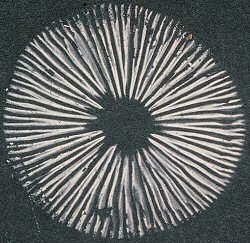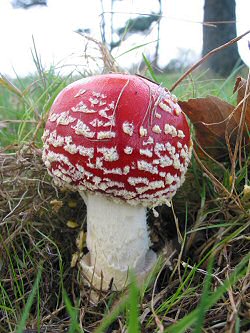Countryside Rangers Diary
November
Mushroom Month
 The woods and grasslands are full of mushrooms, toadstools and other fungi of all shapes and sizes. You can’t make a permanent collection of fungi, but if the spore cap is of the umberella type, you can make a spore print. On many mushrooms of this type, tiny spores are found under the cap on the gills. If the gills are white it is best to use dark paper. Remove the stem of the mushroom with a knife and place the cap on a sheet of paper overnight. The next day lift the cap off carefully and below will be a spore print. You can fix this by spraying lightly with artists’ fixative spray.
The woods and grasslands are full of mushrooms, toadstools and other fungi of all shapes and sizes. You can’t make a permanent collection of fungi, but if the spore cap is of the umberella type, you can make a spore print. On many mushrooms of this type, tiny spores are found under the cap on the gills. If the gills are white it is best to use dark paper. Remove the stem of the mushroom with a knife and place the cap on a sheet of paper overnight. The next day lift the cap off carefully and below will be a spore print. You can fix this by spraying lightly with artists’ fixative spray.
Spores are so tiny you can only see each one by itself if you look through a microscope. Otherwise all you see is a fine powder. It is thought that large bracket fungi that grow on trees can produce hundreds of millions of spores every hour, and that even a medium sized field mushroom will produce over 1,500,000,000 spores in a few days.
 Fly Agaric (Amanita muscaria) is our most familiar, best known and the most frequently drawn and photographed fungus. Widespread and common it is always associated with birch trees and found on heaths and in mixed woodland. They can be seen at the edge of New Pond this month.
Fly Agaric (Amanita muscaria) is our most familiar, best known and the most frequently drawn and photographed fungus. Widespread and common it is always associated with birch trees and found on heaths and in mixed woodland. They can be seen at the edge of New Pond this month.
The Red cap is distinctly covered with white flecks. It has white gills and stem white with a ring. This fungi is highly poisonous.
A wealth of myth and legend surrounds it. There have been various suggestions as to the source of the name of this fungus. The most simple interpretation relates to the habit in Europe since mediaeval times, and possibly before this, of using it to stupefy flies, by putting pieces of the cap in milk or sugared water, or by sprinkling sugar on the cap. These lures were placed on window-sills.
A further more complex interpretation of the name goes as follows. Accounts of the effects of eating the fungus vary from a claim that "it puts partakers into a peaceful and gentle mood similar to the effect of opium", to the complete opposite. The Vikings were said to use it to go "berserk" (the word derives from the bear-skin shirt worn by the warriors). One writer, Wasson, surmised that the origin of the name therefore relates to the similar maddening effect of various flies, such as the Warble Fly, or the Gadfly, on reindeer and cattle, causing them to "gad about". He lists many phrases from several languages, linking apparently drunken behaviour with flies and an even more sinister connection with Satanism. Satan is known as "Lord of the Flies" and the name "Beelzebub" derives from the Hebrew "Ba’al Zevuv", literally "Lord of the Fly".
One characteristic effect of Fly Agaric intoxication is the distortion of size, in particular everything appearing much larger or smaller than usual This gives rise to speculation as to how much Lewis Carroll knew about the fungus. An enduring image from "Alice’s Adventures in Wonderland" is that of the caterpillar sitting on a toadstool and smoking from a hookah, looking down at a diminutive Alice who is the same height as the toadstool. The Caterpillar says: " One side will make you grow taller and the other side will make you grow shorter". "One side of what? The other side of what?" thought Alice to herself. "Of the mushroom" said the Caterpillar, just as if she had asked it aloud.
The Koryak were a shamanistic (their religion allowed priests or witch-doctors to mediate with the gods or spirits), reindeer-herding people. A Koryak would swallow a cap of Amanita muscaria as an agent of divination, to direct his spirit. The reindeer herded by the Koryak were also very fond of the Fly Agaric and were said to travel miles in search of a crop which they would then eat until collapsing in a "trance".
The red colour of the cap of the Fly Agaric with its white decoration, the flying effect of its intoxications, and the association with reindeer all contributed to the development of the myth of Santa Claus by an American professor in the early nineteenth century. The features quoted were translated into the merry figure of Santa Claus with his red coat with white buttons and trimmings, his flying sledge drawn by reindeer, who like the shaman, is the bringer of gifts from the gods. His arrival down the chimney derives from a feature of the winter dwellings built by Siberian tribes. These were excavations in the ground which could be entered only by a hole in the roof which also served as a smoke hole. This was the symbolic entrance and exit for the spirit of the shaman engaged in "flight".
Important Note
Amanita muscaria, the Fly Agaric is a poisonous mushroom whose effects are very unpredictable. It can be fatal in large doses and experimentation is definitely not to be recommended.